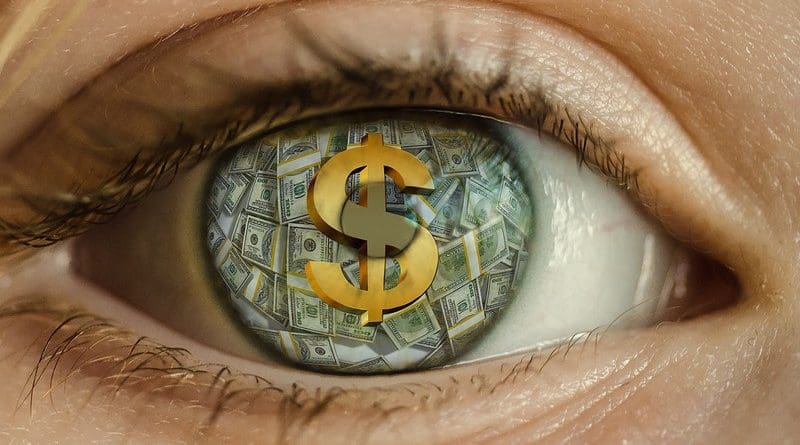Today’s Fiat Dollar Standard Is Founded In Lies – OpEd
By MISES
By Manuel Tacanho*
We live in the age of rampant (monetary and price) inflation, more frequent economic crises, chronic deficit spending, unpayable debt, and massive financial bubbles. That’s not accidental. That’s consequential.
This fact and the many economic, social, and even cultural consequences of our fiat money system remain largely unknown to the majority of people. The US dollar became a fiat currency by deceit and not due to the merit of fiat money or by free choice.
So much so that economist Jacques Rueff titled his book The Monetary Sin of the West (1971) in reference to the Bretton Woods gold exchange standard, which was not even a full fiat money system.
What is fiat money? you may ask. Essentially, it is an inconvertible or unbacked currency usually issued by the government/central bank. Fiat money is currency of unlimited supply.
The word fiat comes from Latin and means “let it be done,” used in the sense of a government order and decree. Another key word here is inconvertible. Notice that fiat emerged from paper currency no longer being redeemable for silver and gold.
The US dollar, euro, and all national currencies today are fiat. Thus they can be easily and “endlessly” created, printed, if you prefer. In addition to that, because of fractional reserve banking, commercial banks also create large amounts of money by lending it into existence—artificial credit expansion.
A Brief Recap
For context, let me briefly describe how the Bretton Woods gold exchange system morphed into the global fiat dollar standard.
Bretton Woods is the name the allied nations, led by the United States, gave to the monetary system they designed to govern global trade after World World II because the conference took place in Bretton Woods, New Hampshire, in 1944.
Participating countries agreed that the US dollar would be backed by gold at a fixed exchange rate of $35 per ounce, and that, in turn, other currencies would be linked to the dollar. Hence the name “gold exchange standard” as opposed to the classical gold standard.
This is how the US dollar became the world’s reserve currency. On the promise to be the bridge, or the link, between gold and all other currencies.
Notice, however, that under this arrangement, only governments and central banks could redeem (convert) paper currency for gold. Neither citizens nor businesses were allowed to. Which is a big red flag.
Because governments are not particularly known for honesty and exercising fiscal discipline, as time passed and in order to keep financing its ever-growing spending programs, chief among them war and an expanding welfare state, the US found itself printing more dollars than it could back with gold.
Noticing this, a handful of European countries rightly began to doubt the US’s ability to keep its gold convertibility commitment in light of the increasing currency creation (monetary inflation). This led some countries, France in particular, to start redeeming their paper dollars for gold. Other countries followed suit.
As pressure to redeem mounted, the Nixon administration on August 15, 1971, unilaterally ended the dollar’s convertibility to gold—the very thing that gave the dollar stability, trustworthiness, and international acceptance. Nixon announced:
I have directed Secretary Connally to suspend temporarily the convertibility of the dollar into gold or other reserve assets, except in amounts and conditions determined to be in the interest of monetary stability and in the best interests of the United States.
In more candid words, the US government defaulted and broke its promise to exchange gold for dollars. That’s how we ended up with today’s global fiat money system—the dollar standard.
Plus the rampant monetary, financial and economic instability; tyranny; and injustice that comes with a fiat money system.
Twenty twenty-one marked the fiftieth anniversary of this “temporary” suspension and thus of the global fiat money system. And despite the worsening socioeconomic situation, given today’s prevalent economic thinking, it is hard, perhaps inconceivable, to imagine the US restoring any sort of link between the dollar and gold in the foreseeable future.
It is worth noting that the “crime of ’71” was simply the final blow against moral and sound money and the final step in the journey to fiat money, which, in my view, started in 1913, with the establishment of the current US central bank, the Federal Reserve System.
Today’s global fiat money system, the dollar standard, originated from government trickery and deception by self-serving politicians serving special interest groups, who colluded to bring about a full fiat money system. To the benefit of the ruling elites and in detriment to everyone else.
Now suppose the American public, back in 1971, had been well informed and aware of the insidiously destructive nature of fiat money. Would they have allowed their government to make the dollar a fiat currency?
The reality is humanity lives under a fiat money system. But as sound economics shows and history proves, fiat money is an unreliable and fallible form of money that always comes to an economically and socially destructive end.
*About the author: Manuel Tacanho is founder of Afridom, a sound money based digital banking startup for Europe and Africa. He’s also an advocate of free markets and sound money for Africa’s economic development.
Source: This article was published by the MISES Institute

